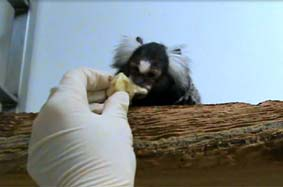Reflections of an NC3Rs student

As I am now in the throes of completing my PhD thesis, it is a good time to reflect back upon the journey: the training and opportunities, the connections I have made, and the impact of my research.
I began my PhD in 2011, under the dedicated supervision of Professor Hannah Buchanan-Smith at the University of Stirling, where I am assessing the welfare of laboratory-housed common marmosets (Callithrix jacchus) born and raised under different rearing backgrounds.
Figure 1 (top right): Supplementary feeding of triplet infants. Photo by Dstl.
The common marmoset is the most frequently used New World primate in laboratory research and testing. Despite their use, there are problems associated with their breeding, including increasing litter sizes (twins are the norm in the wild), high infant mortality and the need for supplementary feeding involving family separation to improve survival of larger litters, which may be associated with adverse consequences for the infants. My project involved working with a UK laboratory who were already breeding common marmosets, to identify and promote factors associated with dam longevity and twin litters, as well as to assess the effect of rearing background on a number of welfare measures, to determine best practice for dealing with large litters.
The NC3Rs has supported me throughout this project. I remember being asked to present at the Grant Holders meeting in my first year, which I was nervous about, especially with such distinguished delegates. However, it was a great opportunity to hone my presentation skills, and since then, I have been invited to many other NC3Rs events, which are always informative and friendly. I have especially fond memories of the first Summer School in Cambridge, which brought all the PhD students together to share our experiences and learn more about the 3Rs.
I am also thankful to have had the opportunity to visit some amazing places for conferences. For example, last year I presented my research at the II Latin American Congress and XV Brazilian Congress of Primatology in Brazil. Later, I was fortunate enough to be able to see marmosets in the wild at Nicola Schiel’s field sites, which gave me a new perspective on their behaviour in captivity.
However, not everything went to plan. The facility I was originally working with unfortunately stopped breeding marmosets, and now with very few colonies in the UK, I was grateful to be allowed to continue the project at another site in 2012. I learnt that being adaptable and taking opportunities where I could find them is very important in research.
As well as having the support of staff at this facility, I have been fortunate enough to collaborate with several leading researchers to develop a wide range of skills. For example, I worked with Dr Tessa Smith at the University of Chester, where I learnt how to collect and analyse cortisol using ELISAs. I have also honed my behavioural observation skills, one of the most important ways to assess animal welfare, and developed tests for cognitive bias and anhedonia in marmosets.
This year, I was delighted when my paper, entitled ‘Long-term data on reproductive output and longevity in captive female common marmosets (Callithrix jacchus)’, was accepted for publication in the American Journal of Primatology. This study involved the help of three UK sites, who provided colony records over several decades, to investigate dam longevity and litter size. Results suggest that ensuring appropriate housing and diet and minimal disturbance are beneficial for dam longevity, while maintaining females at lower healthy weights may help to reduce the frequency of large litters, which are associated with high infant mortality.
The following month, I presented these results at the Primate Society of Great Britain meeting in Oxford. I also talked about my study looking at infant development in marmosets raised under different conditions. Behavioural observations suggest some differences in independence and family rearing style between infants of different litter sizes. Given all the wonderful presentations, I was honoured to be awarded the prize for ‘Best Student Talk’. As many presentations were concerning wild primates, I was pleased that the judges valued the welfare of captive primates and recognised that the 3Rs are so important to those housed in laboratories.
I am now entering the final stages of my PhD, writing up my studies looking at the stress response to routine weighing and the affective state (emotions) of adult marmosets of different rearing backgrounds. I found that while some supplementary fed animals coped better with a stressful event, others had a reduced expectation of and interest in rewards, which could affect stress resilience. However, across the range of measures taken, there was surprisingly little difference between marmosets of different litter sizes and rearing backgrounds. This suggests that the current supplementary feeding procedure, along with a regular human socialisation programme, minimises the potential adverse effects of early separation.

Figure 2 (above): Positive human interactions. Photo by Dstl.
Gaining evidence to enhance the welfare of laboratory housed marmosets was of great importance to me, and I am grateful that the NC3Rs funds such meaningful projects, with the potential to make a real difference to the lives of animals used in research. I feel privileged to work with these animals, and hope to continue working in this area.
